Greater than or equal to in Excel is a crucial comparison operator that helps users analyze data and make informed decisions. By utilizing this function, users can easily identify values in a dataset that meet specific criteria, such as being greater than or equal to a certain threshold. Whether it’s filtering data, creating conditional formatting rules, or performing calculations, the greater than or equal to operator enhances Excel’s functionality and versatility. With its straightforward syntax and wide range of applications, Excel empowers users to manipulate and analyze data efficiently. Whether you’re a beginner or an advanced user, mastering the greater than or equal to operator in Excel is essential for effective data analysis and decision-making.
This Tutorial Covers:
- Introduction of “Greater Than or Equal To” (>=) operator in Excel
- How to utilize the “Greater Than” (>) and “Greater Than or Equal to” (>=) operator in Excel
- Example 1– Using the basic “Greater Than” and “Greater Than or Equal to” operator
- Example 2– Using the IF Function with “Greater Than or Equal to” operator
- Example 3– Using the SUMIF Function with “Greater Than or Equal to” operator
- Example 4– Using the COUNTIF Function with “Greater Than or Equal to” operator
- Most Commonly Asked Questions
1. Introduction of “Greater Than or Equal To” (>=) operator in Excel:
The “Greater Than or Equal To” (>=) operator in Excel is a comparison operator used to compare two values and determine if one value is greater than or equal to the other. The operator returns a Boolean value of TRUE or FALSE based on the result of the comparison.
The syntax for the greater than or equal to the operator is as follows:
= value1 >= value2
Here, value1 and value2 represent the values that you want to compare. If value1 is greater than or equal to value2, the operator will return TRUE, and if not, it will return FALSE.
The greater than or equal to the operator is commonly used in Excel formulas and functions, as well as in conditional formatting, to perform calculations and analysis on data sets. It is a valuable tool for data analysis and can help you to identify trends and patterns in your data.
2. How to utilize the “Greater Than” (>) and “Greater Than or Equal to” (>=) operator in Excel?
For a better understanding of how the provided comparison operators in Excel are used, let’s look at a few examples.
-
Example 1– Using the basic “Greater Than” and “Greater Than or Equal to” operators:
Suppose we have a dataset like the one below.

The steps to use basic “Greater Than” and “Greater Than or Equal to” operator in Excel are described below:
Step 1: Apply the below formula in cell G2 and you can either copy and paste the formula or drag the formula’s fill handle to the remaining cells.
=E2>11%
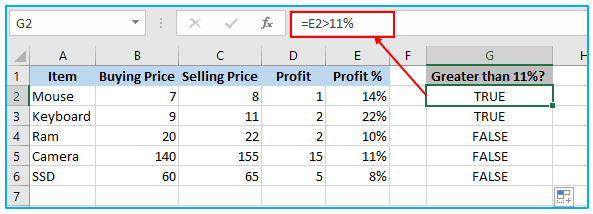
We must switch the comparison operator to “greater than or equal to” (>=) in order to include 11% in the test.
The cell G5 value “true” is returned by the “greater than or equal to” operator. This suggests that cell E5 has a value that is either more than or equal to 11%.

-
Example 2– Using the IF Function with “Greater Than or Equal to” operator:
Suppose you have a table of test scores for a class of students. You want to assign grades based on the scores.
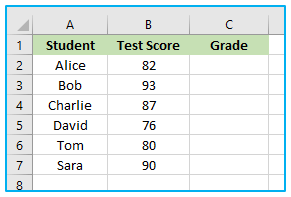
How to use IF Function with the “Greater Than or Equal to” operator in Excel is shown below:
Step 1: Apply the below formula in cell C2 and you can either copy and paste the formula or drag the formula’s fill handle to the remaining cells.
= IF(B2 >= 90, “A”, IF(B2 >= 80, “B”, IF(B2 >= 70, “C”, “F”)))
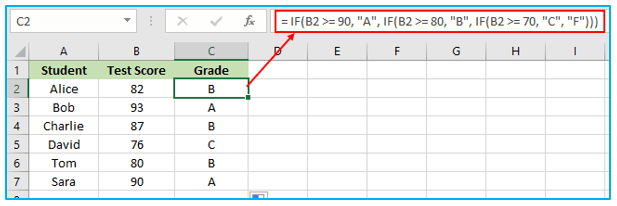
This formula assigns grades based on the test scores. If the score is 90 or higher, the formula assigns an “A” grade. If the score is between 80 and 89, the formula assigns a “B” grade. If the score is between 70 and 79, the formula assigns a “C” grade. If the score is below 70, the formula assigns an “F” grade. The “Greater Than or Equal to” operator is used to compare the test score to the cutoffs for each grade level.
-
Example 3– Using the SUMIF Function with “Greater Than or Equal to” operator:
Suppose we have a dataset like the one below.
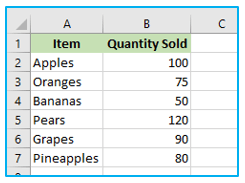
Procedure of Using the SUMIF Function with “Greater Than or Equal to” operator in Excel is shown below:
Step 1: Apply the below formula in cell D3 and you can either copy and paste the formula or drag the formula’s fill handle to the remaining cells.
=SUMIF(B2:B7, “>=80”)
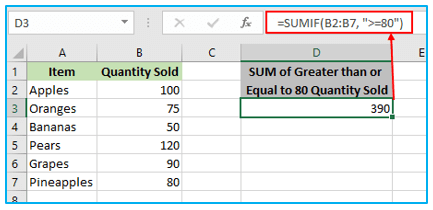
In this formula:
- B2:B7 is the range of quantities we want to evaluate
- The standard we would like to use for the range is “>=80” (i.e., only total values larger than or equal to 80).
When we enter this formula, Excel will evaluate the quantities in the range B2:B7 and only sum the values that are greater than or equal to 80. In this case, the formula will return a total of 390, which is the sum of the quantities for Apples, Pears, Grapes, and Pineapples.
-
Example 4– Using the COUNTIF Function with “Greater Than or Equal to” operator:
Suppose we have a dataset like the one below.
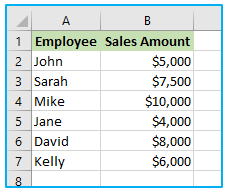
How to use COUNTIF Function with “Greater Than or Equal to” operator in Excel is shown below:
Step 1: Apply the below formula in cell D3 and you can either copy and paste the formula or drag the formula’s fill handle to the remaining cells.
=COUNTIF(B2:B7, “>=7500”)
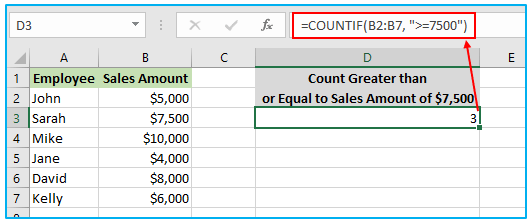
In this formula:
- B2:B7 is the range of sales amounts we want to evaluate
- “>=7500” is the criteria we want to apply to the range (i.e., only count values that are greater than or equal to $7,500)
When we enter this formula, Excel will evaluate the sales amounts in the range B2:B7 and count the number of values that are greater than or equal to $7,500. In this case, the formula will return a count of 3, which is the number of employees who made sales of $7,500 or more (Sarah, Mike, and David).
3. Most Commonly Asked Questions:
The following are some of the most typical queries regarding Excel’s “Greater Than or Equal to” operator:
What does the phrase “Greater Than or Equal to” in Excel mean?
An Excel comparison operator called “Greater Than or Equal to” enables you to determine whether one value is greater than or equal to another.
What is the function of the Excel “Greater Than or Equal To” operator?
In Excel, all you need to do to utilize the “Greater Than or Equal to” operator is type the symbol (>=) between the two values you want to compare. If the value in cell A1 is more than or equal to the value in cell B1, for instance, the formula “=A1>=B1” might be used to test this.
What distinguishes the Excel operators “Greater Than” and “Greater Than or Equal to”?
In contrast to the Excel Greater Than or Equal to operator, which also compares values, the “Greater Than” operator merely checks whether one value is greater than another. For instance, if you were comparing the values 5 and 5, the “Greater Than” operator would return FALSE, whereas the “Greater Than or Equal to” operation would return TRUE.
How to utilize Excel’s SUMIF function with the “Greater Than or Equal to” operator?
The “Greater Than or Equal to” operator can be used with Excel’s SUMIF function by including it in the criterion argument. As an illustration, “=SUMIF(A1:A5, “>=10″, B1:B5)” would add the values in column B when the matching value in column A is greater than or equal to 10.
How to utilize Excel’s COUNTIF function with the “Greater Than or Equal to” operator?
You can add the “Greater Than or Equal to” operator to the criterion input when using Excel’s COUNTIF function. In the range A1:A5, for instance, “=COUNTIF(A1:A5, “>=10″)” would count the number of cells where the value is higher than or equal to 10.
Is it possible to utilize Excel’s “Greater Than or Equal To” operator with text values?
The “Greater Than or Equal to” operation in Excel cannot be applied to text values.
Is it possible to utilize dates in Excel’s “Greater Than or Equal To” operator?
In Excel, you may use the “Greater Than or Equal to” operator with dates. When comparing dates, Excel treats earlier dates as “smaller” than later dates, therefore a date value that is higher than or equal to another date value denotes that the event happens on or after that day.
How to use Excel’s “Greater Than or Equal To” operator in conjunction with other operators?
When formulating more complex criteria, you can combine the “Greater Than or Equal to” operator with other operators (such “AND” or “OR”) to achieve the desired results. For instance, “=IF(AND(A1>=10, B1=20), “Yes”, “No”)” would return “Yes” if the values in cells A1 and B1 are higher than or equal to 10 and less than or equal to 20, respectively.
How to use conditional formatting in Excel with the “Greater Than or Equal to” operator?
The “Greater Than or Equal to” operator can be used in Excel’s conditional formatting to highlight cells that satisfy particular requirements. Use conditional formatting, for instance, to draw attention to cells with values more than or equal to a specific threshold.
When using Excel’s “Greater Than or Equal to” operator, are there any frequent mistakes or danger zones to be aware of?
Making sure you are using the appropriate data type for your values is a typical mistake to watch out for when using the “Greater Than or Equal to” operator in Excel. For instance, Excel might not recognize a value you unintentionally entered as text when you were comparing numbers, which could cause your formula to fail.
Application of Greater Than or Equal to in Excel
- Conditional Formatting: Apply formatting rules to highlight cells containing values greater than or equal to a specified threshold, aiding in data visualization and analysis.
- Filtering Data: Filter datasets to display only those entries where a particular value is greater than or equal to a specified criterion, facilitating targeted analysis.
- Logical Functions: Use in conjunction with logical functions like IF, AND, and OR to create sophisticated conditional formulas for decision-making processes.
- Data Validation: Set up data validation rules to ensure that input values entered into cells meet certain criteria, such as being greater than or equal to a minimum threshold.
- Chart Creation: Utilize in chart creation to specify data points or series that should be included based on being greater than or equal to certain values, enhancing visual representation.
- Statistical Analysis: Employ in statistical analysis to identify data points or outliers that meet or exceed certain thresholds, aiding in trend identification and anomaly detection.
For ready-to-use Dashboard Templates:
